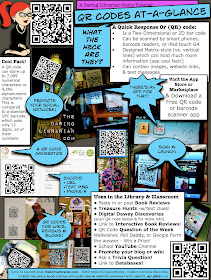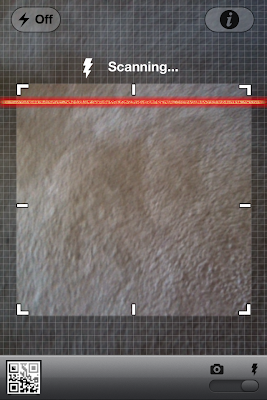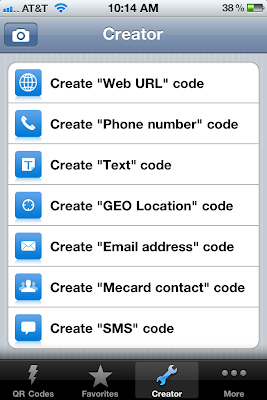 |
| This code should take you to the blog you're reading right now. |
 |
| Click the image to make it large enough for you to read comfortably |
The public is starting to see these QR codes on business-related things, but I think teachers can use them in the classroom. If you'd like to read about all the ways you can use these codes in the classroom, please visit my blog post: Using QR Codes in the Classroom. First, though, let's go over the basics.
How do I scan a QR code?
Users can download a number of QR code-scanning applications onto their smart phones and use them to "read" QR codes. I know there are QR code-scanning apps available for Apple products and Android smartphones. {There might be options for Blackberry and other "smart" device users, but I'm not aware of them since I primarily deal with Apple products.}
Since I have an iPhone, I'll be using that device as my frame of reference for how-to's and screenshots in this post. I'm sure Android and other "smart" devices that have QR code-reading apps have very similar processes.
When you go into the Apple app store and search for "QR code reader," you find a fairly lengthy list of available apps. Most are free, but I've seen some apps that cost anywhere from $1 to $3. Since I'm cheap, I download the free ones. ;) My favorite QR code-reading app for my iPhone so far is QR Reader for iPhone by TapMedia Ltd.
 |
| Source |
It really doesn't matter which QR code-reading app you pick, although I will be using the above-mentioned app for my how-to. Gigaom has a list of their top 5 picks for QR code readers for iPhone. Mashable lists 7 QR code readers for Android. ...Take your pick!
Once I download QR Reader for iPhone and open the application, I see a screen that looks as though I'm supposed to take a picture. This is the "scanning" screen. You'll see a square template that will fit a QR code perfectly and a red line that moves vertically on the screen {as though it's "scanning" the code}.
 |
| That's my needs-to-be-vacuumed carpet inside the square template... :) |
As you can see, reading QR codes with a smart device is pretty easy. Next time you're in public and see a QR code, you can whip out your smart phone, open the scanning app, and unveil whatever information the creator wants you to see.
Don't have access to a smart device at school? Kristin at iTeach 1:1 wrote a great article titled, "How To Scan QR Codes if You Don't Have an iThing." Richard Byrne explains another way in his article titled, "Decode QR Codes without a Camera."
Why should I scan codes?
Sometimes businesses offer coupons or incentives to visitors who view their QR code information.
It's much easier to scan a QR code with your phone than it is to try to type a URL into your phone's browser with those tiny smart phone keys! QR codes are particularly convenient when a URL is super-long and complicated. In addition, since QR codes can convey things other than website links; they are a quick and easy way to get lots of information.
Sounds interesting. How can I use them in my classroom?
For some of my former students, a smart phone is the only internet access they have. So what happens when they try to visit one of my websites via their phone? Sometimes they can't remember the website address and are unable to do any of the research they needed to do. Other times, the small buttons on their smart phones prevent them from typing in the URL correctly; thus, they are unable to find the website and do the assignment. You get the idea.
While I think technology is great, it sometimes is an excuse for students. I've had many students tell me they "couldn't get the website to work at home." If you provide QR codes for all links you need your students to visit, that's just one more way they can get their homework done {and a good chance that user-errors will be eliminated}.
So what if we, as teachers, start posting our QR codes in our classroom? You could start out very simple and just generate codes for your classroom website, blog, Twitter page, Facebook page, and/or school phone number. You could place these codes on the syllabus {for older students} or the classroom newsletter {for younger students}. You could place QR codes on your business cards to hand out to students and parents at the beginning of the year or to your audience when you teach a workshop. When you pass out instructions for a web-project in your class, place the QR code at the top of your information sheet. One school I used to visit regularly had a display that read, "Meet the Teachers." Each teacher is featured on a page that contains his/her name, grade/subject, and a QR code. I scanned the codes while I was waiting one day, and found out that all the codes link back to the teachers' Alma maters! That would be interesting to place outside your door on "Meet the Teacher" night.
These codes can provide another way to get in touch with you and/or to review the classroom information. The more methods you provide for accessing that information, the higher the probability it will be accessed!
The point is, you can create another (and possibly simpler) way for students and parents to contact you. The more venues we, as teachers, have for communicating with our students and their parents, the more questions that can be answered. No one can argue that that's not a lofty goal!
I don't necessarily think this is a better communication method than the tried-and-true "write it down" method, but it just might be eye-catching, different, and "cool" enough to get folks to access your info.
I'm on board. How do I create codes of my own?
You can generate QR codes by using an application on your smart device or a website. Let's start by generating a code from your smart phone's application, since that's what we've been working with so far. Open your QR Reader for iPhone app, and click the square QR code button in the bottom left corner. That will take you to a screen that has links to all the QR codes you've scanned with that application so far. On the bottom toolbar, hit "creator," and you'll see a screen like the one below:
From there, it's just a matter of picking which kind of code you'd like to generate. Once you click on your desired code, you're taken to another screen that prompts you to type in your information. For instance, when I click Create "Web URL" code, I'm taken to a screen that asks for a web URL. All I have to do is type in the URL, click "create" in the top right corner, and I see my new code. To share it with others, click "save" in the top right corner. I always click "share QR image" and e-mail the image to myself before I do anything else. That way, I have the image on my computer to put on websites {or use for blog posts}. You can also share it on Facebook, Twitter, or Tumblr; save it to your photo album; or copy it to your clipboard. Once you share it, users must scan the information using their QR reader-app of choice, and they're taken to whatever information you'd like them to see.
Easy as that.
You could also generate your QR code online from a computer. There are so many QR code-generating website out there, but the ones I use most frequently are GoQR.me, Kaywa, and Kerem Erkan. I think the first two are the most simple to use, but they lack some features that Kerem Erkan's generator has.
No matter what code-generating website you choose to use, all you have to do is find the correct form to fill out (are you linking to a website? a Google map? a specific tweet? just a block of text?), type in the requested information, and watch as the website does all the hard work. Once you generate the code, you can save it to your desktop or share it on your social media websites for others to start reading your code.
More articles about QR codes in the classroom:
- Vicki Davis from Cool Cat Teacher
- How to read a QR code if you don't have an iThing
- "QR Codes in the Classroom" presentation by CPSB.org
- Tons of QR code articles on Scoop.it
Interested in using QR codes, but you're just unsure how to incorporate them? Click HERE to go to my blog post with 40+ ways to use them.


No comments:
Post a Comment